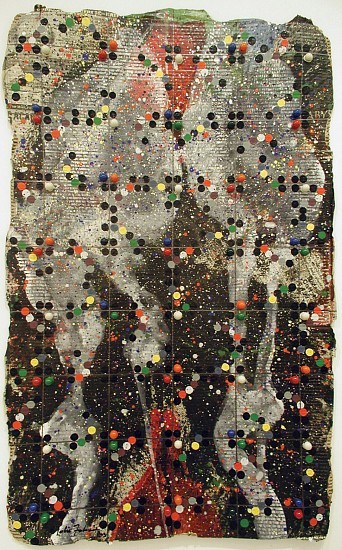Born in Tokyo, Japan, Nobu Fukui is an American citizen, but still identifies as an Asian Modern and Contemporary artist. He currently lives and works in New York.
Upon emigrating to the United States, Fukui studied at the Art Students League in New York City in the mid-1960s.
Although Fukui’s art has evolved over the ensuing decades – and has clearly imbibed many influences from global and American contemporary artistic movements – he still considers himself – in part – an artist who fundamentally began as a product of the revolutionary Gutai Art Association, or Japanese Movement, formed by a group of avant-garde Japanese contemporary artists in 1954.
The Gutai Art Association was founded by the painter Jiro Yoshihara in Ashiya, Japan, and heralded, in its manifesto, a desire to “represent radical and energetic approaches to artmaking that encompass performance, painting installation, and theatrical events and to take advantage of the freedoms available in their newly democratic homeland.”
When considering the style of Fukui’s grid-like, dense, and rhythmic paintings over the years, the words all critics use are: “energetic,” “animated” and “intense.”
At times Fukui’s works look extremely close to collapsing from “considered” into “chaotic.” All begin as grids; some with highly stylized symbols and references drawn from traditional Japanese screens; others that mimic Western game boards.
They are all then plastered with (and nearly obliterated by) layers of paint, newspaper clippings, swatches of fabric, beads, and other embellishments.
As one critic from The New York Times described one piece: “No single point in them holds the eye. In some, color comes and goes in intense bursts, relieved by quieter areas, as in the vary large “Christmas Day,” in which ectoplasmic shapes of gray trailing streams and runs of paint hover on a festive, varicolored Expressionist ground lighted up like an abstract version of Times Square.
These works are not soothing nor contemplative, Yet, as the same New York Times critic noted, Mr. Fukui, who has been on the exhibiting scene since the 1960’s, is still a painter of impressive drive and energy.
Fukui’s output has never slowed, nor has his output waned. He has been showcased in gallery shows, primarily at intermittent exhibitions at The Margaret Thatcher Projects, and once viewed, the context of the confluence of Gutai and the pulsing art scene of 1960s New York melded in the mind and on the canvas of this unique artist.
One understands how the newly won freedom to experiment for Japanese artists served as a jumping off point for him early in his career. – and how the fusion with his Japanese aesthetic heritage melded to his American experience informs his work.
This is especially true when one considers the dates of the Japanese Art Movement. It was founded at precisely the critical moment when Jackson Pollock and the Abstract Expressionists were taking center stage on the global contemporary art scene, and continued throughout the 1960s, with the advent of Pop Art.
Further, the Gutai artists were not acting in a vacuum, and were in fact, as their journal said, actively “working with global scope, strategic awareness and towards international common ground.”
During this period, as Fukui was studying in New York, his Japanese contemporaries were collaborating with an extensive list of artistic leading lights in Europe and New York (including the composer John Cage, Christo, choreographer Merce Cunningham, sculptor Isamu Noguchi and Robert Rauschenberg),
One imagines how these collaborations and the artistic discourse they sparked influenced Fukui. The Gutai emphasized: “Discarding the frame, getting off the walls, shifting from immobile time to lived time, we aspire to create a new painting.”
Visit The Foundation
If you are interested in visiting the RAK foundation and its collection, we would be happy to show you around. Contact us for more information.
